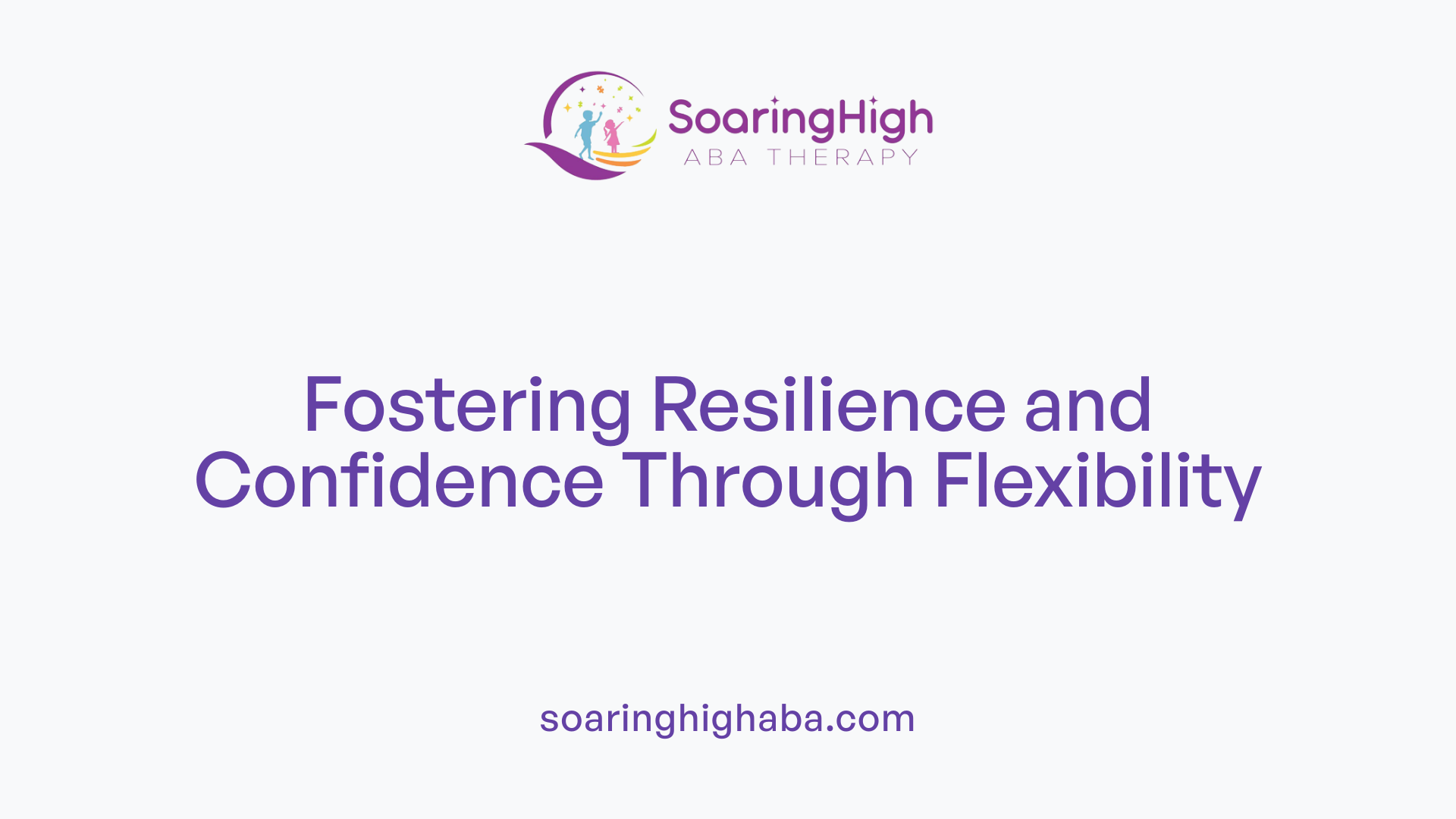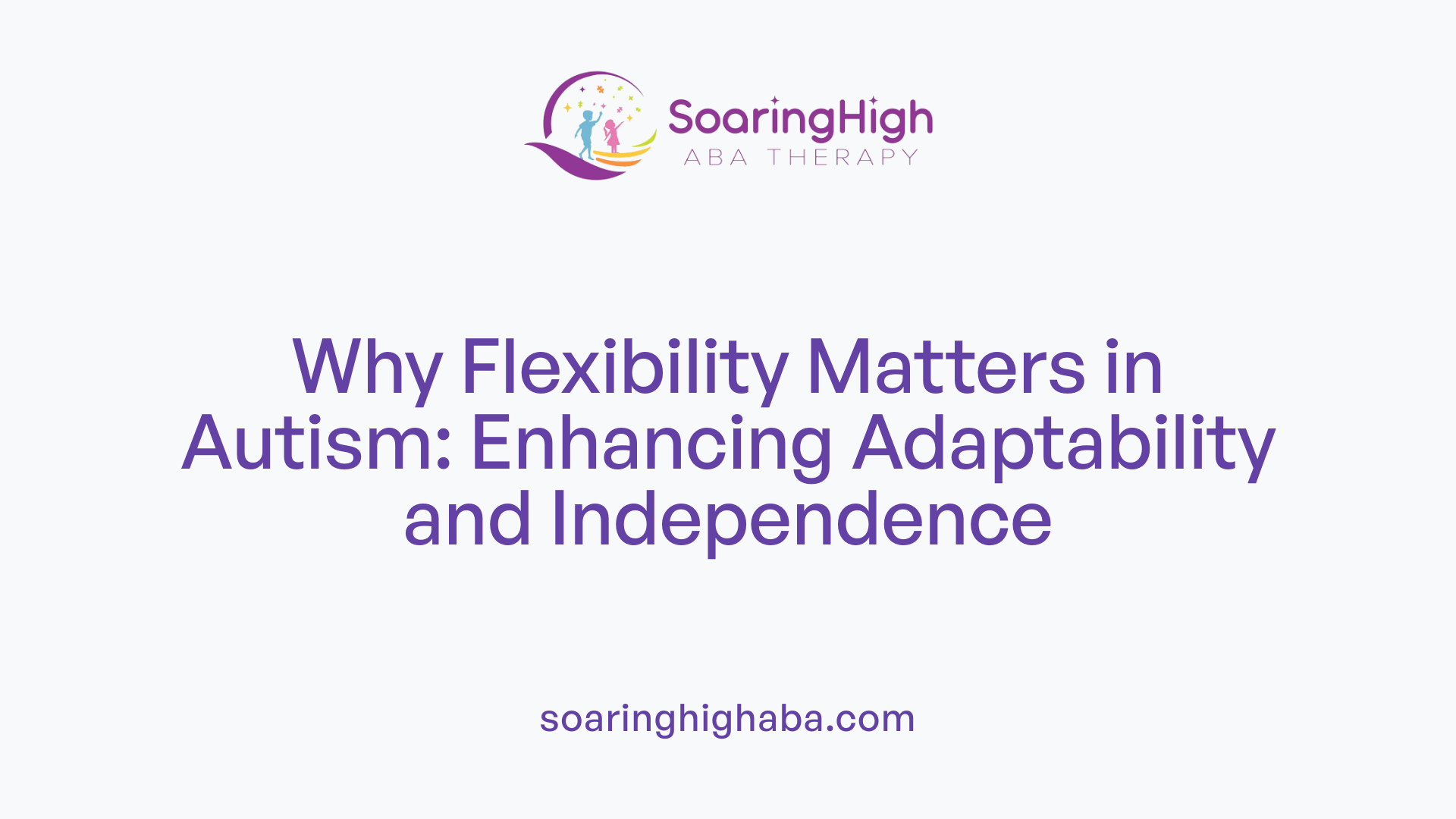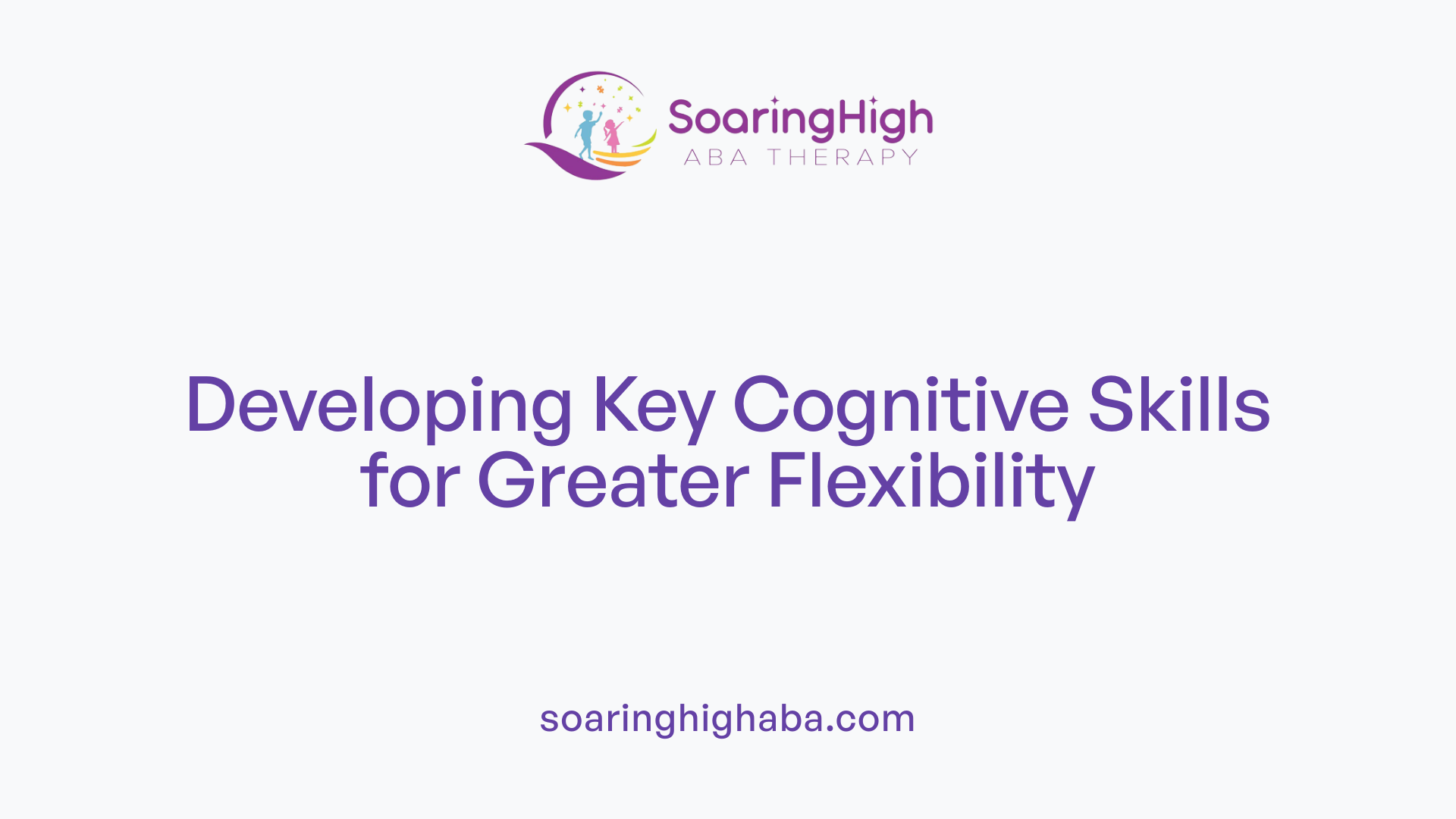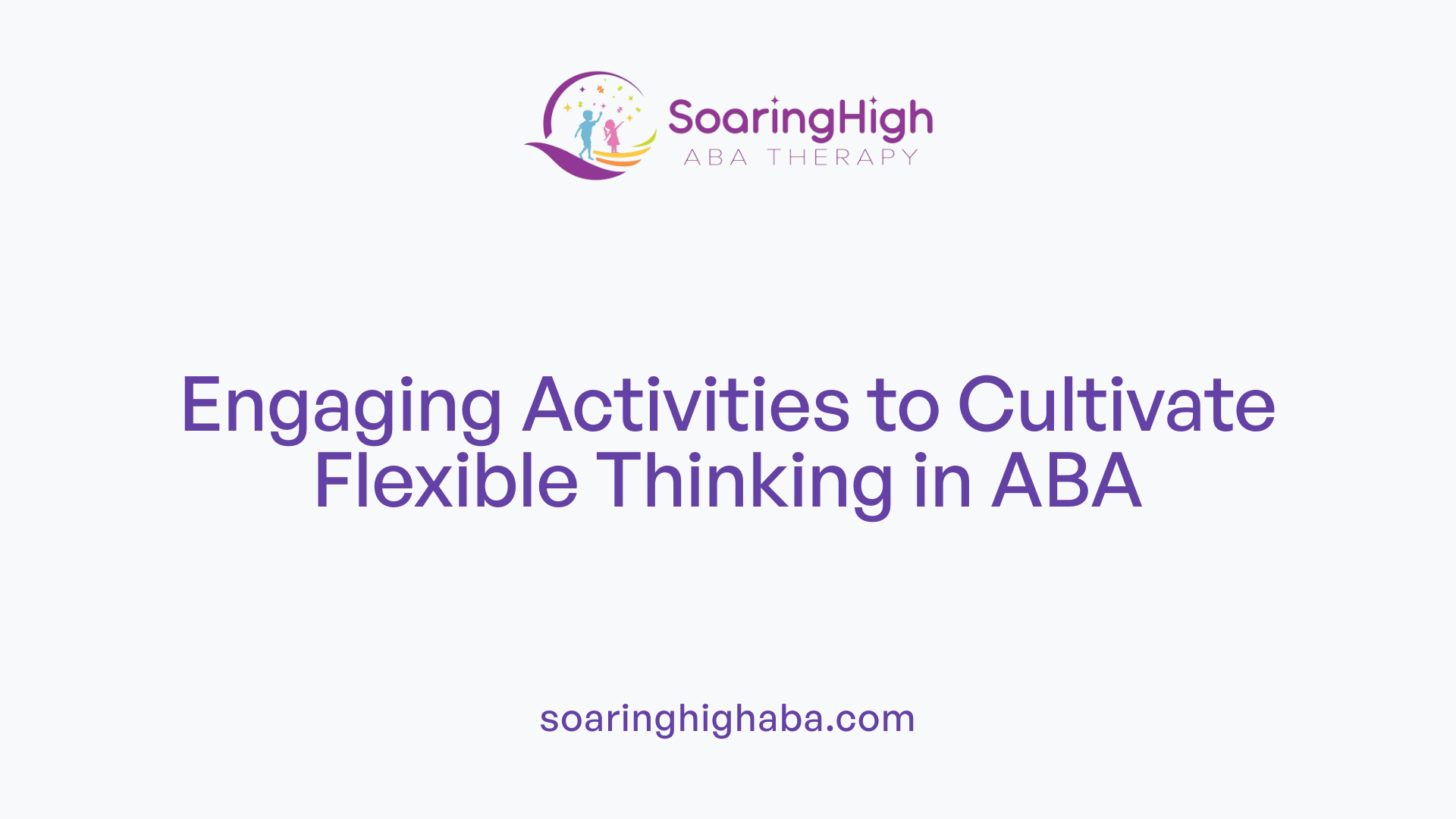Unlocking Adaptive Thinking Through ABA Techniques
Teaching flexible thinking skills within ABA therapy is a transformative approach that empowers children with autism to navigate the complexities of daily life with confidence and resilience. By integrating specialized frameworks such as ACT, AIM, and DNA-V, therapists can develop tailored interventions that foster adaptability, reduce anxiety, and improve social and problem-solving skills. This article explores the principles, strategies, and activities that underpin effective teaching of flexible thinking in ABA, emphasizing the importance of holistic, values-based learning.
Establishing Flexible Responding in ABA

What does it mean to establish flexible responding in ABA?
Establishing flexible responding in ABA means teaching children and individuals with autism to adapt their thoughts and actions to fit different and often changing situations. This skill involves more than just following routines; it fosters the ability to adjust behavior when plans shift unexpectedly or when new challenges arise.
A core part of this process is helping individuals use visual supports effectively. Visual cues, such as schedules or signs, help them understand and respond to new circumstances calmly and confidently. These supports serve as external guides that promote clarity and reduce frustration.
Positive reinforcement plays a crucial role. By rewarding flexible behaviors immediately, children learn that adaptable responses lead to positive outcomes. Reinforcements tailored to their interests—like preferred activities or rewards—encourage consistent practice of flexible responding.
Incorporating interactive activities enhances learning. Social skills games, emotion recognition tasks, and problem-solving exercises make the process engaging. These activities simulate real-life situations, providing opportunities for children to practice adjusting their responses.
Creating a predictable yet flexible environment is important. This means maintaining a structured routine while gradually introducing variations. For example, changing the order of activities or using different materials for familiar tasks helps children become more resilient to change.
Overall, establishing flexible responding aims to develop resilience, improve social interactions, reduce anxiety related to change, and build problem-solving skills. It supports children in becoming adaptable, confident, and capable of managing life’s unpredictability through fun, meaningful learning experiences.
The Significance of Teaching Flexibility in Autism Spectrum Disorder

Why is teaching flexible thinking skills important in autism spectrum disorder?
Teaching flexible thinking skills is crucial for individuals with autism because it directly impacts their ability to adapt to new or changing situations. Autism often involves a preference for routines and difficulty handling unexpected changes, which can lead to frustration and anxiety.
By developing the capacity to think flexibly, individuals can better manage transitions and embrace new experiences. This adaptability not only reduces stress but also fosters resilience as they learn to approach problems with creativity and openness.
Flexibility also enhances problem-solving skills. When children and young people learn to consider multiple options and alternative solutions, they become more confident and independent in navigating daily challenges.
Additionally, flexible thinking improves social interactions. Since social environments are often unpredictable, being able to respond adaptively helps in understanding social cues, responding appropriately, and engaging more effectively.
In essence, teaching flexible thinking empowers those with autism to handle life's complexities with greater ease, promoting longer-term independence and well-being.
Cognitive Skills Targeted in ABA Therapy

What are cognitive skills in ABA?
In ABA therapy, cognitive skills such as attention, memory, problem-solving, and executive functions are targeted to promote cognitive growth and help children with autism develop essential thinking skills.
Attention involves focusing on relevant stimuli while filtering out distractions, which is crucial for learning and social interaction. Memory training helps children retain and recall information, supporting academic and daily life skills.
Problem-solving encourages children to find solutions to challenges, fostering independence and adaptability. Executive functions, including flexible thinking, self-control, planning, and organization, are vital for managing behaviors, transitions, and adjusting to changes.
Developing these skills in ABA is often achieved through structured activities like games, social interactions, and visual supports. Incorporating principles from Acceptance and Commitment Therapy (ACT), such as mindfulness and data-driven decision making, further supports cognitive flexibility.
Activities like using visual schedules, role-play, and social stories help enhance these skills. Overall, focusing on these cognitive areas helps children improve their learning, adapt better to their environment, and reduce frustration caused by inflexible thinking or attention difficulties.
| Cognitive Skill | Description | Intervention Examples |
|---|---|---|
| Attention | Focusing on stimuli and tasks | Visual cues, timers, focused activities |
| Memory | Retaining and recalling information | Repetition, mnemonic devices, storytelling |
| Problem-solving | Finding solutions to challenges | Puzzle tasks, scenario-based activities |
| Executive Functions | Planning, self-control, cognitive flexibility | Visual schedules, role play, self-monitoring tools |
Enhancing these abilities benefits children by increasing their resilience, independence, and social competence in various settings.
Activities to Promote Flexible Thinking within ABA

What are some activities that can be used to develop flexible thinking skills within ABA therapy?
Developing flexible thinking skills is essential for children with autism to adapt effectively to changing environments and challenges. ABA programs incorporate various engaging and practical activities that target cognitive flexibility.
One common approach involves problem-solving tasks such as puzzles, pattern recognition games, and sorting activities. These exercises encourage children to think creatively and consider multiple solutions, enhancing their ability to adapt their thinking.
Role-playing scenarios and social stories are also effective. These activities help children practice perspective-taking, understand different social cues, and respond flexibly in social interactions. Pretend play, where children act out various roles, fosters imagination and adaptability.
Routine modifications are another key method. Changing the order of daily activities or introducing last-minute changes helps children learn to accept and navigate unexpected situations. For example, switching the sequence of tasks during teaching sessions or altering activity choices trains children to be more adaptable.
Visual schedules prove particularly useful in teaching flexibility. Interactive visual tools that can be easily modified allow children to see the changes in their routines and understand that shifts are manageable. Using visual cues for flexible versus inflexible behavior also reinforces these concepts.
Finally, engaging children in logic games, brainstorming sessions, and scenario planning enhances their critical thinking skills. These activities promote openness to different approaches, problem-solving from various angles, and resilience in face of challenges.
By integrating these activities into ABA therapy, practitioners can help children develop the flexibility needed for more adaptive, resilient behaviors and better social functioning.
Integrating frameworks like ACT, AIM, and DNA-V into ABA
How can ABA therapy incorporate frameworks like ACT, AIM, or DNA-V to promote flexibility?
ABA therapy can effectively embed approaches such as Acceptance and Commitment Therapy (ACT), the AIM curriculum, and the DNA-V model to foster greater adaptability in learners. These frameworks are centered on developing psychological flexibility, which is crucial for managing changes and challenges.
At the core, ACT emphasizes accepting internal experiences and staying present through mindfulness, while defusing from rigid thoughts. This helps individuals detach from inflexible patterns and encourages behaviors aligned with personal values. The hexaflex model, a key component of ACT, includes acceptance, present-moment awareness, cognitive defusion, self-as-context, values, and committed action—all working together to enhance flexibility.
The AIM curriculum takes these principles further by offering structured lessons that tailor mindfulness, acceptance, and data-driven strategies to each learner. It promotes resilience and flexibility, teaching children to connect actions with their intrinsic values in ways that suit their developmental stage.
Similarly, the DNA-V model guides learners through discovering their strengths (Discoverer), noticing their thoughts and feelings (Noticer), understanding internal advice (Advisor), and clarifying personal values (Values). This four-role approach helps children recognize and modify rigid thought patterns, fostering resilience and adaptable thinking.
Together, these models support a holistic, strengths-based approach within ABA. They go beyond simple reinforcement by addressing internal experiences, emotional regulation, and stress management. Integrating these frameworks into ABA enables practitioners to help children develop not just skills but also motivated, flexible, and values-aligned responses.
In summary, incorporating ACT, AIM, and DNA-V into ABA builds a comprehensive, meaningful pathway for promoting flexibility. It aligns behavior change with personal growth, life goals, and psychological well-being, leading to more adaptive and resilient individuals.
For more information, search: "Using ACT AIM DNA-V frameworks in ABA for flexibility." This approach continues to expand as more practitioners recognize the importance of values-driven, flexible behavior in supporting long-term success.
Psychological Flexibility and Its Impact on Well-Being
What activities can be used to develop flexible thinking skills within ABA therapy?
Building flexible thinking in children with autism is a fundamental part of developing broader cognitive and social abilities. Several practical activities are incorporated within ABA therapy to encourage adaptability and resilience.
Play activities and games are central tools for promoting flexible responses. For example, engaging children in game-based learning that involves changing rules or scenarios encourages them to adapt quickly and think creatively. Social interactions also serve as natural settings for practicing flexibility, where children learn to respond to different social cues and unexpected changes.
To foster adaptability, strategies such as altering routines and making physical changes to their environment are effective. Introducing new or varied activities helps children learn to navigate unfamiliar situations confidently. Planning scenarios and brainstorming options allow children to explore multiple solutions, cultivating problem-solving skills.
Visual supports, like visual signs indicating flexible or inflexible behaviors, help children recognize and repeat adaptable responses. These tools make abstract concepts tangible, aiding generalization of flexible thinking across settings.
Overall, integrating these activities within ABA not only enhances cognitive flexibility but also reduces stress by equipping children to handle change more comfortably. As they become more resilient, their social competence and emotional well-being also improve, laying the foundation for more adaptive lifelong skills.
Conclusion: The Long-Term Impact of Teaching Flexibility in ABA
Teaching flexible thinking within ABA programs has profound, lasting benefits for individuals with autism. When children learn to think adaptively, they become better equipped to handle the uncertainties of daily life, which fosters resilience. This resilience enables them to recover from setbacks more quickly and approach new situations with confidence.
Moreover, developing flexibility enhances independent problem-solving. Children and young people can analyze situations from multiple angles, brainstorm different options, and implement effective solutions without relying solely on adult guidance. Such skills are vital for navigating diverse environments, from home to school and the community.
Flexibility also improves social adaptability. Being able to adjust responses, understand others’ perspectives, and respond appropriately to changing social cues makes interactions more successful and fulfilling. This, in turn, helps build stronger relationships and reduces frustrations caused by rigid behaviors.
Lastly, flexible thinking supports overall life skills. It encompasses cognitive, social, and emotional competencies that contribute to a person’s ability to manage daily challenges, pursue personal goals, and participate fully in society. By embedding these skills into early intervention and ongoing ABA practice, individuals with autism can experience greater independence, increased confidence, and improved quality of life.
| Skill Area | Benefit | Examples |
|---|---|---|
| Resilience | Bounces back from setbacks, handles stress better | Recovering from routine changes, overcoming frustrations |
| Independent Problem-Solving | Works through challenges effectively | Using multiple solutions, planning steps independently |
| Social Adaptability | Adjusts to different social situations | Responding to social cues, flexible in conversations |
| Overall Life Skills | Gains confidence in daily activities | Managing routines, self-advocacy, exploring new interests |
Ultimately, explicit teaching of flexible thinking fosters a mindset that supports lifelong growth, independence, and social participation. The investment in developing these skills today paves the way for more adaptive, resilient, and empowered individuals tomorrow.
Fostering Adaptive Minds for a Better Future
Integrating principles from ACT, AIM, and DNA-V into ABA therapy provides a comprehensive approach to developing flexible thinking skills in children with autism. These strategies not only enhance immediate social and emotional functioning but also set the stage for lifelong resilience, problem-solving, and independent living. By prioritizing values-based learning and cognitive flexibility, therapists and families can support children in achieving more adaptive, confident, and fulfilling lives, ultimately fostering a future where they can thrive amidst life's inevitable changes.
References
- Mastering Flexibility: ABA Strategies That Work
- ABA Therapy for Kids: Promoting Flexible Thinking
- Teaching Flexibility - An Important Skill - Autism Awareness Centre
- ABA Therapy and Executive Functioning: Building Skills for Success
- [PDF] Teaching Flexible Thinking - Middletown Centre for Autism
- Incorporating ABA Therapy Activities into Daily Routines at Home
- 10 Cognitive Development Activities for Preschoolers with Autism
- Creating Autism Interventions that Promote Flexibility





































































































